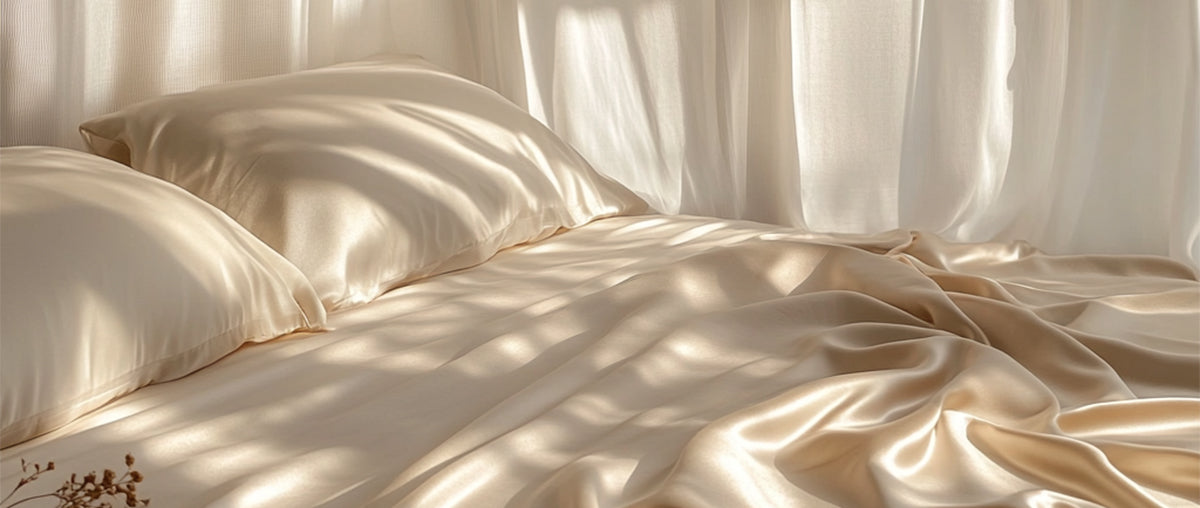Premium satin bedsheets represent more than just a purchase, they're an investment in daily comfort and bedroom aesthetics. Like all quality investments, proper care dramatically extends their lifespan and preserves their luxurious look and feel. The good news? Maintaining satin's sumptuous qualities requires less effort than you might think with just some consistent attention to a few key principles.
This comprehensive guide covers everything from routine washing to storage, troubleshooting common issues, and establishing care routines that maintain satin's distinctive lustre and smooth hand-feel. With proper maintenance, quality satin bedsheets can provide years of luxury sleep experiences, making them among the most worthwhile home textile investments.

Understanding Satin: The Foundation of Proper Care
Effective satin care begins with understanding what makes this luxury fabric unique. Unlike conventional cotton, satin features a distinctive weave structure where threads "float" over several others before interlacing. This creates satin's characteristic smooth surface and lustrous appearance but also require a specific care approach.
The common misconception that satin is inherently "delicate" leads many owners to overwash or underwash their sheets. Modern premium satin bedding, particularly from quality manufacturers like Stoa Paris, offers remarkable durability when maintained properly. The key lies not in treating satin as fragile, but in understanding its specific needs.
Washing Wisdom: The Perfect Clean
Perhaps no aspect of satin care generates more questions than proper washing procedures. Follow these guidelines for optimal results:

Water Temperature Matters
Contrary to common belief, satin can be washed in warm water at typically 30-40°C and provides ideal cleaning without stressing fibres. Avoid extreme temperatures on either end; very hot water can damage fibre integrity, while cold water may not adequately remove body oils that gradually dull satin's lustre.
For white or very light satin, occasional washing at 40°C helps maintain brightness without compromising the fabric's structure. Darker satins benefit from slightly cooler temperatures (30°C) to preserve colour depth.
Detergent Selection
The ideal detergent for satin bedsheets should be:
- Mild or gentle in formulation
- Liquid rather than powder to prevent residue
- Free from optical brighteners that can alter colour
- Without fabric softeners which coat fibres and reduce lustre
Many premium detergents marketed for "silks and delicates" work beautifully for satin, though standard quality liquid detergents without fabric softeners also perform well. The key consideration is using the correct amount as excess detergent creates residue that dulls satin's natural sheen.
Cycle Selection
Most modern washing machines offer ideal cycles for satin bedsheets. Look for:
- Delicate/Gentle cycles that reduce mechanical agitation
- Medium spin speeds (800-1000 RPM) that remove moisture without creating excessive wrinkling
- Extended rinse options that ensure complete detergent removal
If your machine lacks specific gentle settings, use shorter cycles with medium spin speeds and ensure thorough rinsing.
Washing Frequency
Quality satin bedsheets typically require washing after 7-10 days of use, similar to conventional cotton sheets. However, several factors might suggest more or less frequent washing:
- Climate considerations: In humid environments or during summer months, more frequent washing (every 5-7 days) prevents oils and moisture from dulling the fabric
- Seasonal adjustments: During cooler months when perspiration is reduced, extending to 10-14 days may be appropriate
- Personal factors: Skin type, sleep habits, and whether you shower before bed all influence optimal washing frequency
The visual indicator for washing isn't always visible soiling, but rather when satin begins losing its characteristic lustre. This is a sign that body oils have accumulated on the fabric surface.

Drying Without Damage: Preserving Satin's Integrity
Proper drying significantly impacts satin's appearance and longevity. Follow these guidelines for best results:
The Air-Drying Advantage
While modern satin blends can tolerate gentle machine drying, air-drying delivers superior results in maintaining satin's distinctive properties:
- Partial spin-drying: Begin by using your washing machine's spin cycle to remove excess moisture
- Avoid direct sunlight: While tempting, direct sun can fade colours and potentially weaken fibres
- Indoor or shaded outdoor drying: Choose well-ventilated locations away from direct sunlight
- Minimal stretching: Hang sheets without excessive pulling or stretching that might distort the weave
Perfect air-drying results in sheets that require minimal ironing while maintaining maximum lustre and smooth hand-feel.
Machine Drying Guidelines
When time constraints necessitate machine drying, follow these precautions:
- Low heat settings only: High temperatures can damage satin's fibre structure
- Remove while slightly damp: Take sheets out before completely dry to minimise wrinkling
- Avoid overdrying: Excessive drying creates static and may cause fibre stress
- Use dryer balls: Wool dryer balls reduce static and help maintain sheet smoothness better than plastic varieties
Immediately removing and properly folding sheets after machine drying significantly reduces wrinkling and maintains satin's characteristic drape.

The Ironing Question: When and How
Perhaps no aspect of satin care sparks more debate than ironing. The truth lies somewhere between "always" and "never" as quality satin bedsheets benefit from occasional ironing but rarely require it after every wash. Consider these guidelines:
When to Iron
- Special occasions: When hosting guests or seeking perfect presentation
- After improper drying: If sheets were overdried or left folded while damp
- Seasonal refreshing: Beginning of new seasons for perfectly crisp appearance
- Extended storage: After taking sheets out of longer-term storage
Proper Ironing Technique
When ironing becomes necessary, follow these steps for optimal results:
- Iron while slightly damp for easiest wrinkle removal
- Use medium heat settings with steam function enabled
- Iron on the reverse side whenever possible to protect the satin face
- Move the iron in the direction of the fabric grain rather than randomly
- Avoid letting the iron rest in one position which can create shine spots
Many satin owners discover that proper folding while slightly damp after washing eliminates the need for regular ironing as the sheets naturally release wrinkles when placed on the bed.

Storage Solutions: Maintaining Quality Between Uses
Proper storage between use cycles preserves satin's quality, particularly for seasonal bedding or guest room sheets:
Optimal Storage Conditions
- Complete dryness: Ensure sheets are thoroughly dry before storage to prevent mildew
- Acid-free environment: Avoid cardboard boxes which may contain acids that transfer to fabric
- Cotton storage bags: Allow breathability while protecting from dust
- Avoid plastic containers: These can trap moisture and create yellowing
- Moderate temperature: Extreme heat or cold can affect fibre integrity
Folding vs. Rolling
While conventional wisdom suggests folding sheets for storage, many textile experts recommend rolling satin sheets instead. Rolling minimises sharp creases that can stress fibres while creating natural-looking drape when next used.
If folding is preferred, use broader, rounder folds rather than sharp creases, and avoid placing heavy items on top of stored satin bedding.
Troubleshooting Common Issues
Even with proper care, occasional issues may arise. Here's how to address the most common satin bedsheet concerns:
Lustre Loss
If satin sheets begin losing their characteristic sheen despite regular washing:
The solution: Mineral buildup from hard water is often the culprit. Add a quarter cup of white vinegar to the rinse cycle to remove residue, followed by an extra rinse cycle with clean water. For severe cases, professional laundering or specialised textile detergents designed to remove mineral deposits may be necessary.
Snags and Pulls
Small snags occasionally occur with satin sheets due to jewellery, rough skin, or pet claws:
The solution: Never cut pulled threads. Instead, carefully work the snag to the reverse side using a needle, then secure with tiny stitches. For larger pulls, professional repair may be required.
Pilling Concerns
Quality satin rarely pills extensively, but minor pilling can occur, particularly with newer sheets:
The solution: Use a fabric shaver designed specifically for delicate textiles, working very gently across the surface. After removing pills, launder normally and you'll typically find that pilling decreases with subsequent washes as loose fibres are removed.
Colour Fading
Darker satin colours may gradually fade over many wash cycles:
The solution: For colour preservation, wash in cooler water, use colour-preserving detergents, avoid direct sunlight when drying, and turn sheets inside-out during washing to protect the primary surface.
Seasonal Care Considerations for Indian Homes
India's diverse climate creates unique seasonal satin care requirements:
Monsoon Season Precautions
During humid monsoon months:
- Increase washing frequency to prevent mildew development
- Ensure complete drying before placing on beds or storing
- Consider using dehumidifiers in bedroom spaces
- Add a few drops of tea tree oil to final rinse water for natural antimicrobial protection
Summer Maintenance
During hot, dry periods:
- Rinse sheets thoroughly to remove all detergent residue that might irritate skin
- Consider slightly more frequent washing to address increased perspiration
- Store unused sheets in cool, dark locations to prevent colour fading
- Air-conditioning environments may require less frequent washing due to reduced perspiration
Winter Considerations
During cooler months:
- Slightly less frequent washing may be appropriate
- Indoor drying becomes more practical and colour-preserving
- Static electricity increases so using appropriate fabric conditioners in the final rinse helps manage this issue
The Economics of Quality Care
Proper satin sheet maintenance delivers significant economic benefits beyond the obvious aesthetic advantages:
- Extended lifespan: Well-maintained satin bedsheets typically last 3-5 years of regular use, compared to 1-2 years for improperly maintained linens
- Sustained performance: Proper care ensures satin maintains its distinctive feel and appearance throughout its lifespan
- Reduced replacement costs: The initial investment in quality satin bedding is amortised over many more years with proper maintenance
- Energy efficiency: Appropriate washing and drying techniques consume less water and electricity than excessive or improper care routines

Creating Your Satin Care Routine
Establishing a consistent care routine dramatically simplifies satin maintenance while ensuring optimal results:
Weekly Habits
- Rotate sheets halfway through the week by turning them top-to-bottom to distribute wear
- Fluff and rearrange pillows daily to maintain satin pillowcase smoothness
- Remove decorative elements that might snag or stress the fabric when sleeping
Monthly Practices
- Inspect sheets for any developing issues like loose threads or minor stains
- Address any small concerns before they become significant problems
- Consider a "refresher" pressing for heavily used areas if needed
Seasonal Attention
- At season changes, assess your satin bedding's condition
- Address any accumulated minor issues
- Consider professional laundering once yearly for deep cleaning beyond home care capabilities
Professional Care: When to Seek Expert Assistance
While routine maintenance falls well within home care capabilities, certain situations warrant professional textile cleaning:
- Stubborn stains: Particularly oil-based or pigmented stains resistant to gentle home treatment
- Persistent odours: Sometimes embedded scents require professional treatment
- Colour restoration: Professional services can sometimes revitalise faded satin
- Special finishes: Sheets with unique decorative elements may require specialised cleaning
Many premium dry cleaners offer specific services for luxury bedding. When selecting a service provider, inquire about their experience with satin specifically, as improper professional cleaning can damage delicate fabrics.
The Sustainable Perspective: Care as Conservation
Proper satin care represents not just economic but environmental stewardship:
- Reduced consumption: Well-maintained bedding requires less frequent replacement which reduces resource utilisation
- Energy conservation: Appropriate washing temperatures and air-drying reduce energy consumption
- Water preservation: Correct detergent amounts and washing frequencies optisize water usage
- Chemical minimisation: Gentle, appropriate cleaning products reduce harmful chemical introduction into water systems
By maintaining your luxury bedding properly, you're participating in more sustainable consumption patterns without sacrificing quality or comfort.
The Final Assessment: Is Satin Worth the Care?
Given the specific maintenance requirements, potential satin owners often question whether the fabric justifies the attention. The answer lies in satin's unique benefits:
- Sleep quality enhancement: Satin's smooth surface reduces sleep disruption from fabric friction
- Temperature regulation: Quality satin adapts to body temperature better than many alternatives
- Skin and hair benefits: Reduced friction means less facial creasing and hair breakage
- Unmatched aesthetic appeal: No other bedding fabric offers satin's distinctive lustre and drape
For those valuing these qualities, the modest maintenance requirements represent worthwhile investments in daily comfort and bedroom aesthetics.
With proper care, premium satin bedsheets deliver years of luxury sleep experiences, making them among the most worthwhile home textile investments available to discerning homeowners.

Explore Stoa Paris's collection of premium satin bedsheets, designed for both luxury and longevity. Each set includes comprehensive care instructions to help maintain their exceptional quality for years to come.






Share:
How to Keep Your Bedding Fresh & Clean During the Hot Summer Months
The Art of Layering: How to Style Your Bed Like a Pro